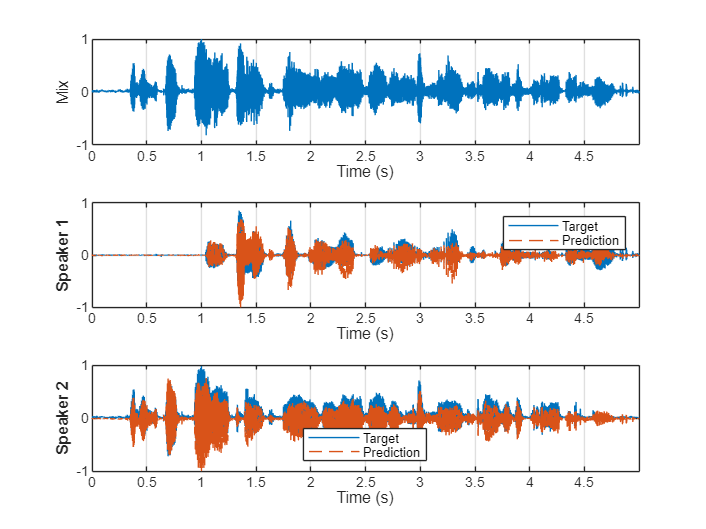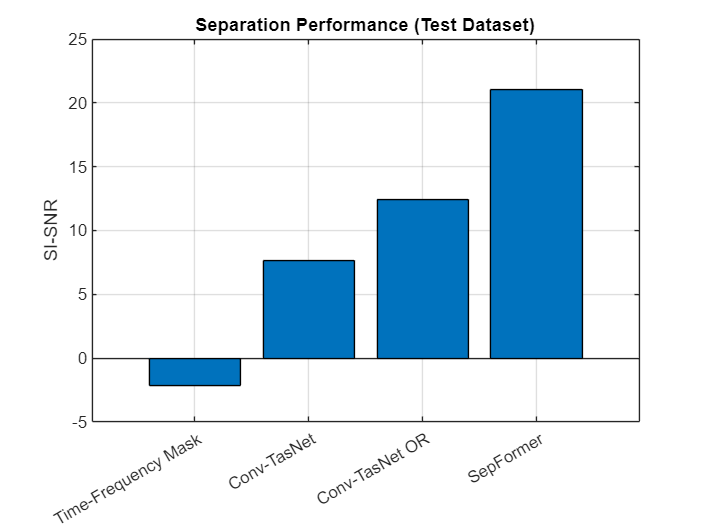Compare Speaker Separation Models
Compare the performance, size, and speed of deep learning speaker separation models.
Introduction
Speaker separation is a challenging and critical speech processing task. Modern speaker separation methods use deep learning to achieve strong results. In this example, you compare four speaker separation models:
You can find the training recipes for the time-frequency masking model and the 2-speaker ConvTas-Net model in Cocktail Party Source Separation Using Deep Learning Networks and Train End-to-End Speaker Separation Model, respectively. You can perform speaker separation using the one-and-rest Conv-TasNet (Conv-TasNet OR) model and the SepFormer model with the separateSpeakers function.
Load Test Data
To spot-check model performance, load test data consisting of two speakers and their mix. Listen to the speakers individually and mixed. Plot the mix and individual speakers using the supporting function, plotSpeakerSeparation.
[audioIn,fs] = audioread("MultipleSpeakers-16-8-4channel-5secs.flac");
t1 = audioIn(:,2);
t2 = audioIn(:,3);
x = t1 + t2;
x = x/max(abs(x));
plotSpeakerSeparation(t1,t2,x)
sound(t1,fs),pause(5) sound(t2,fs),pause(5) sound(x,fs),pause(5)
Load Models
Time-Frequency Masking
Load the pretrained speaker separation weights for the time-frequency masking model. The inference model is defined in the supporting function separateSpeakersTimeFrequency. To examine and train this model, see Cocktail Party Source Separation Using Deep Learning Networks.
downloadFolder = matlab.internal.examples.downloadSupportFile("audio/examples","cocktailpartyfc.zip"); dataFolder = tempdir; tfNetFolder = fullfile(dataFolder,"CocktailPartySourceSeparation"); unzip(downloadFolder,tfNetFolder)
Separate the mixed test signal and then plot and listen to the results.
y = separateSpeakersTimeFrequency(x,tfNetFolder); plotSpeakerSeparation(t1,t2,x,y)

sound(y(:,1),fs),pause(5) sound(y(:,2),fs),pause(5)
Conv-TasNet
Load the pretrained speaker separation weights for the Conv-TasNet model. The inference model is defined in the supporting function separateSpeakersConvTasNet. To examine and train this model, see Train End-to-End Speaker Separation Model.
downloadFolder = matlab.internal.examples.downloadSupportFile("audio","speechSeparation.zip"); dataFolder = tempdir; unzip(downloadFolder,dataFolder) convtasNetFolder = fullfile(dataFolder,"speechSeparation");
Separate the mixed test signal and then plot and listen to the results.
y = separateSpeakersConvTasNet(x,convtasNetFolder); plotSpeakerSeparation(t1,t2,x,y);

sound(y(:,1),fs),pause(5) sound(y(:,2),fs),pause(5)
Conv-TasNet with One-and-Rest Permutation Invariant Training
The separateSpeakers function uses three models under-the-hood: a 2-speaker SepFormer model, a 3-speaker SepFormer model, and a one-and-rest Conv-TasNet model. To use the one-and-rest Conv-TasNet model, specify NumSpeakers as 1 or do not specify the NumSpeakers. When NumSpeakers is not specified, the function passes the "rest" from the separation back through the model until no more speakers are detected. For the purposes of this example, call separateSpeakers twice with NumSpeakers=1 for both calls.
Separate the mixed test signal and then plot and listen to the results. If you have not downloaded the required files to use separateSpeakers, an error is thrown with the link to the download.
[y1,r] = separateSpeakers(x,fs,NumSpeakers=1); [y2,r] = separateSpeakers(r,fs,NumSpeakers=1); plotSpeakerSeparation(t1,t2,x,[y1,y2])

sound(y1,fs),pause(5) sound(y2,fs),pause(5)
SepFormer
Call separateSpeakers with NumSpeakers=2 to perform speaker separation using the 2-speaker SepFormer model.
Separate the mixed test signal and then plot and listen to the results.
y = separateSpeakers(x,fs,NumSpeakers=2); plotSpeakerSeparation(t1,t2,x,y)

sound(y(:,1),fs),pause(5) sound(y(:,2),fs),pause(5)
Compare Models
Compare the computation time, model size, and performance of the models.
Computation Time
To compare execution times for different duration inputs, use the supporting function compareComputationTime. If the execution time is less than the input duration, then the model can run in real time (without dropping samples).
compareComputationTime(DurationToTest=[1,5,10], ... CompareCPU=true, ... CompareGPU=
true, ... TimeFrequencyMaskNetFolder=tfNetFolder, ... ConvTasNetFolder=convtasNetFolder)

Model Size
Compare the size of all models. Note that the Conv-TasNet model trained in the example and the Conv-TasNet OR model provided with the separateSpeakers function are quite different in size. In addition to different loss functions and training recipes, Conv-TasNet OR and Conv-TasNet are both variations on the architecture described in [1]. Most noticeably, the Conv-TasNet OR model uses 24 convolutional blocks while the example Conv-TasNet model uses 32.
timefrequency_size = dir(fullfile(tfNetFolder,"CocktailPartyNet.mat")).bytes/1e6; convtasnet_size = dir(fullfile(convtasNetFolder,"paramsBest.mat")).bytes/1e6; convtasnet_or_size = dir(which("convtasnet-librimix-orpit.mat")).bytes/1e6; sepformer_size = dir(which("sepformer-libri2mix-upit.mat")).bytes/1e6; n = categorical(["Time-Frequency Mask","Conv-TasNet","Conv-TasNet OR","SepFormer"]); n = reordercats(n,["Time-Frequency Mask","Conv-TasNet","Conv-TasNet OR","SepFormer"]); figure bar(n,[timefrequency_size,convtasnet_size,convtasnet_or_size,sepformer_size]) grid on ylabel("Size (MB)") title("Disk Memory")

Compare Scale Invariant Signal to Noise Ratio (SNR)
To compare model performance, download the LibriSpeech [3] test-clean dataset. The dataset consists of files of single speakers reading.
downloadDatasetFolder = tempdir; datasetFolder = fullfile(downloadDatasetFolder,"LibriSpeech","test-clean"); filename = "test-clean.tar.gz"; url = "http://www.openSLR.org/resources/12/" + filename; if ~datasetExists(datasetFolder) gunzip(url,downloadDatasetFolder); unzippedFile = fullfile(downloadDatasetFolder,filename); untar(unzippedFile{1}(1:end-3),downloadDatasetFolder); end ads = audioDatastore(datasetFolder,IncludeSubfolders=true);
Test the model scale-invariant signal-to-noise ratio (SI-SNR) [6] performances on a sampling of the dataset. SI-SNR is a popular objective metric for the quality of speaker separation algorithms. If a GPU and Parallel Computing Toolbox™ are available, use the GPU to speed up processing.
The testModel supporting function combines randomly selected audio files, mixes them, passes the mixed data through the specified model, and then calculates the permutation-invariant SI-SNR.
The SepFormer model achieves the best results (higher SNR is better).
tf_sisnr = testModel(ads,@(x)separateSpeakersTimeFrequency(x,tfNetFolder),UseGPU=canUseGPU); convtasnet_sisnr = testModel(ads,@(x)separateSpeakersConvTasNet(x,convtasNetFolder),UseGPU=canUseGPU); convtasnet_orpit_sisnr = testModel(ads,@(x)separateSpeakers(x,8e3,NumSpeakers=1),UseGPU=canUseGPU,OneAndRest=true); sepformer_sisnr = testModel(ads,@(x)separateSpeakers(x,8e3,NumSpeakers=2),UseGPU=canUseGPU); figure bar(n,[tf_sisnr,convtasnet_sisnr,convtasnet_orpit_sisnr,sepformer_sisnr]) grid on ylabel("SI-SNR") title("Separation Performance (Test Dataset)")

Supporting Functions
Test Model
function testSISNR = testModel(ads,model,options) %testModel Calculate SISNR over dataset arguments ads model options.OneAndRest = false options.UseGPU = false options.NumTestPoints = 50 options.TestDuration = [] options.SignalRatio = [0.6 0.75 0.85 1] end total_sisnr = zeros(options.NumTestPoints,1); fn = ads.Files; spkids = filenames2labels(fn,ExtractBefore="-"); rng default for ii = 1:options.NumTestPoints % Choose a random file for speaker 1 idx1 = randi(numel(fn)); fn1 = fn{idx1}; % Choose another random file for speaker 2, exclude speaker 1 from % possibilities spk1 = spkids(idx1); fnsubset = fn(spkids~=spk1); idx2 = randi(numel(fnsubset)); fn2 = fnsubset{idx2}; % Read audio file and resample to 8 kHz. [t1,fs1] = audioread(fn1); [t2,fs2] = audioread(fn2); t1 = resample(t1,8e3,fs1); t2 = resample(t2,8e3,fs2); % Make files the same length if isempty(options.TestDuration) N = min(numel(t1),numel(t2)); else N = 8e3*options.TestDuration; end t1 = trimOrPad(t1,N); t2 = trimOrPad(t2,N); % Scale audio to abs max of 1 t1 = t1./max(abs(t1)); t2 = t2./max(abs(t2)); % Scale the second speaker according to the scaling ratio t2 = options.SignalRatio(randi(numel(options.SignalRatio)))*t2; % Mix x = t1 + t2; x = x./max(abs(x)); % Use GPU if requested if options.UseGPU x = gpuArray(x); end % Pass signal through model if options.OneAndRest [y1,r] = model(x); y2 = model(r); y = [y1,y2]; else y = model(x); end % Perform permutation invariant signal to noise ratio total_sisnr(ii) = permutationInvariantSISNR(y,[t1,t2]); end testSISNR = gather(mean(total_sisnr)); end
Plot Speaker Separation
function plotSpeakerSeparation(t1,t2,x,y) %plotSpeakerSeparation Plot the ground truth and predictions arguments t1 t2 x y = [] end fs = 8e3; timeVector = ((0:size(t1,1)-1)/fs)'; tiledlayout(3,1) nexttile() plot(timeVector,x) xlabel("Time (s)") ylabel("Mix") grid on xlim tight ylim([-1 1]) % Match the targets and predictions based on which set of pairs results in % the best SI-SNR if ~isempty(y) [~,reorderidx] = permutationInvariantSISNR(y,[t1,t2]); y = y(:,reorderidx); end nexttile() if ~isempty(y) plot(timeVector,t1,"-",timeVector,y(:,1),"--") legend("Target","Prediction") else plot(timeVector,t1) end ylabel("Speaker 1",FontWeight="bold") xlabel("Time (s)") grid on xlim tight ylim([-1 1]) nexttile() if ~isempty(y) plot(timeVector,t2,"-",timeVector,y(:,2),"--") legend("Target","Prediction",Location="best") else plot(timeVector,t2) end ylabel("Speaker 2",FontWeight="bold") xlabel("Time (s)") grid on xlim tight ylim([-1 1]) end
Separate Speakers Using Time-Frequency Masking
function output = separateSpeakersTimeFrequency(mix,pathToNet) %separateSpeakersTimeFrequency STFT-based speaker separation function persistent CocktailPartyNet if isempty(CocktailPartyNet) s = load(fullfile(pathToNet,"CocktailPartyNet.mat")); CocktailPartyNet = s.CocktailPartyNet; end WindowLength = 128; FFTLength = 128; OverlapLength = 128-1; win = hann(WindowLength,"periodic"); % Downsample to 4 kHz mixR = resample(mix,1,2); P0 = stft(mixR, ... Window=win, ... OverlapLength=OverlapLength,... FFTLength=FFTLength, ... FrequencyRange="onesided"); P = log(abs(P0) + eps); MP = mean(P(:)); SP = std(P(:)); P = (P-MP)/SP; seqLen = 20; PSeq = zeros(1 + FFTLength/2,seqLen,1,0); seqOverlap = seqLen; loc = 1; while loc < size(P,2)-seqLen PSeq(:,:,:,end+1) = P(:,loc:loc+seqLen-1); %#ok loc = loc + seqOverlap; end PSeq = reshape(PSeq, [1 1 (1 + FFTLength/2)*seqLen size(PSeq,4)]); estimatedMasks = predict(CocktailPartyNet,PSeq); estimatedMasks = estimatedMasks.'; estimatedMasks = reshape(estimatedMasks,1 + FFTLength/2,numel(estimatedMasks)/(1 + FFTLength/2)); mask1 = estimatedMasks; mask2 = 1 - mask1; P0 = P0(:,1:size(mask1,2)); P_speaker1 = P0.*mask1; speaker1 = istft(P_speaker1, ... Window=win, ... OverlapLength=OverlapLength,... FFTLength=FFTLength, ... ConjugateSymmetric=true,... FrequencyRange="onesided"); speaker1 = speaker1 / max(abs(speaker1)); P_speaker2 = P0.*mask2; speaker2 = istft(P_speaker2, ... Window=win, ... OverlapLength=OverlapLength,... FFTLength=FFTLength, ... ConjugateSymmetric=true,... FrequencyRange="onesided"); speaker2 = speaker2/max(speaker2); speaker1 = resample(double(speaker1),2,1); speaker2 = resample(double(speaker2),2,1); N = numel(mix) - numel(speaker1); mixToAdd = mix(end-N+1:end); speaker1 = [speaker1;mixToAdd]; speaker2 = [speaker2;mixToAdd]; output = [speaker1,speaker2]; end
Separate Speakers Using uPIT ConvTasNet
function output = separateSpeakersConvTasNet(input,netFolder) %separateSpeakersConvTasNet Separate two speaker signals from a mixture % input using 2-speaker Conv-TasNet. persistent learnables states if isempty(learnables) M = load(fullfile(netFolder,"paramsBest.mat")); learnables = M.learnables; states = M.states; end if ~isdlarray(input) input = dlarray(input,"SCB"); end x = dlconv(input,learnables.Conv1W,learnables.Conv1B,Stride=10); x = relu(x); x0 = x; x = x - mean(x,2); x = x./sqrt(mean(x.^2, 2) + 1e-5); x = x.*learnables.ln_weight + learnables.ln_bias; encoderOut = dlconv(x,learnables.Conv2W,learnables.Conv2B); for index = 1:32 encoderOut = convBlock(encoderOut,index-1,learnables.Blocks(index),states(index)); end masks = dlconv(encoderOut,learnables.Conv3W,learnables.Conv3B); masks = relu(masks); mask1 = masks(:,1:256,:); mask2 = masks(:,257:512,:); out1 = x0.*mask1; out2 = x0.*mask2; weights = learnables.TransConv1W; bias = learnables.TransConv1B; output2 = dltranspconv(out1,weights,bias,Stride=10); output1 = dltranspconv(out2,weights,bias,Stride=10); output1 = gather(extractdata(output1)); output2 = gather(extractdata(output2)); output1 = output1./max(abs(output1)); output2 = output2./max(abs(output2)); output1 = trimOrPad(output1,numel(input)); output2 = trimOrPad(output2,numel(input)); output = [output1,output2]; end
ConvTasNet - Conv Block
function output = convBlock(input,count,learnables,state) %convBlock - Convolutional block for ConvTasNet % Conv: conv1Out = dlconv(input,learnables.Conv1W,learnables.Conv1B); % PRelu: conv1Out = relu(conv1Out) - learnables.Prelu1.*relu(-conv1Out); % BatchNormalization: batchOut = batchnorm(conv1Out,learnables.BN1Offset,learnables.BN1Scale,state.BN1Mean,state.BN1Var); % Conv: padding = [1 1] * 2^(mod(count,8)); dilationFactor = 2^(mod(count,8)); convOut = dlconv(batchOut,learnables.Conv2W,learnables.Conv2B,DilationFactor=dilationFactor,Padding=padding); % PRelu: convOut = relu(convOut) - learnables.Prelu2.*relu(-convOut); % BatchNormalization: batchOut = batchnorm(convOut,learnables.BN2Offset,learnables.BN2Scale,state.BN2Mean,state.BN2Var); % Conv: output = dlconv(batchOut,learnables.Conv3W,learnables.Conv3B); % Skip connection output = output + input; end
Trim or Pad Audio Signal to Desired Length
function y = trimOrPad(x,n) %trimOrPad Trim or pad to desired length % Trim or expand to match desired size if size(x,1)>=n % Choose a random starting index such that you still have numSamples % after indexing the noise. start = randi(size(x,1) - n + 1); y = x(start:start+n-1); else numReps = ceil(n/size(x,1)); temp = repmat(x,numReps,1); start = randi(size(temp,1) - n + 1); y = temp(start:start+n-1); end end
Compare Execution Time
function compareComputationTime(options) %compareComputationTime Compare computation time arguments options.DurationToTest options.CompareCPU options.CompareGPU options.TimeFrequencyMaskNetFolder options.ConvTasNetFolder end fs = 8e3; dur = options.DurationToTest; if options.CompareCPU tf.CPU = zeros(numel(dur),1); convtas.CPU = zeros(numel(dur),1); convtas_orpit.CPU = zeros(numel(dur),1); sepformer.CPU = zeros(numel(dur),1); for ii = 1:numel(dur) x = pinknoise(dur(ii)*fs,"single"); tf.CPU(ii) = timeit(@()separateSpeakersTimeFrequency(x,options.TimeFrequencyMaskNetFolder)); convtas.CPU(ii) = timeit(@()separateSpeakersConvTasNet(x,options.ConvTasNetFolder)); convtas_orpit.CPU(ii) = timeit(@()separateSpeakers(x,8e3,NumSpeakers=1,ConserveEnergy=false)); sepformer.CPU(ii) = timeit(@()separateSpeakers(x,8e3,NumSpeakers=2,ConserveEnergy=false)); end convtas_orpit.CPU = 2*convtas_orpit.CPU; % Double to adjust for two-passes of one-and-rest. end if options.CompareGPU tf.GPU = zeros(numel(dur),1); convtas.GPU = zeros(numel(dur),1); convtas_orpit.GPU = zeros(numel(dur),1); sepformer.GPU = zeros(numel(dur),1); for ii = 1:numel(dur) x = gpuArray(pinknoise(dur(ii)*fs,"single")); tf.GPU(ii) = gputimeit(@()separateSpeakersTimeFrequency(x,options.TimeFrequencyMaskNetFolder)); convtas.GPU(ii) = gputimeit(@()separateSpeakersConvTasNet(x,options.ConvTasNetFolder)); convtas_orpit.GPU(ii) = gputimeit(@()separateSpeakers(x,8e3,NumSpeakers=1,ConserveEnergy=false)); sepformer.GPU(ii) = gputimeit(@()separateSpeakers(x,8e3,NumSpeakers=2,ConserveEnergy=false)); end convtas_orpit.GPU = 2*convtas_orpit.GPU; % Double to adjust for two-passes of one-and-rest. end numTiles = double(options.CompareCPU)+double(options.CompareGPU); tlh = tiledlayout(numTiles,1); environments = ["CPU","GPU"]; environments = environments([options.CompareCPU,options.CompareGPU]); for ii = 1:numel(environments) nexttile(tlh) ee = environments(ii); plot(dur,tf.(ee),'b',dur,convtas.(ee),'r',dur,convtas_orpit.(ee),'g',dur,sepformer.(ee),'k', ... dur,tf.(ee),'bo',dur,convtas.(ee),'ro',dur,convtas_orpit.(ee),'go',dur,sepformer.(ee),'ko') legend("Time-Frequency Mask","Conv-TasNet","Conv-TasNet OR","SepFormer",Location="best") xlabel("Input Duration (s)") ylabel("Execution Time (s)") title(ee + " Execution Time") grid on end end
References
[1] Luo, Yi, and Nima Mesgarani. "Conv-TasNet: Surpassing Ideal Time-Frequency Magnitude Masking for Speech Separation." IEEE/ACM Transactions on Audio, Speech, and Language Processing 27, no. 8 (August 2019): 1256-66. https://doi.org/10.1109/TASLP.2019.2915167.
[2] Simpson, Andrew J. R. "Probabilistic Binary-Mask Cocktail-Party Source Separation in a Convolutional Deep Neural Network." arXiv.org, March 24, 2015. https://arxiv.org/abs/1503.06962.
[3] Panayotov, Vassil, Guoguo Chen, Daniel Povey, and Sanjeev Khudanpur. "Librispeech: An ASR Corpus Based on Public Domain Audio Books." In 2015 IEEE International Conference on Acoustics, Speech and Signal Processing (ICASSP), 5206-10. South Brisbane, Queensland, Australia: IEEE, 2015. https://doi.org/10.1109/ICASSP.2015.7178964.
[4] Subakan, Cem, Mirco Ravanelli, Samuele Cornell, Mirko Bronzi, and Jianyuan Zhong. "Attention Is All You Need In Speech Separation." In ICASSP 2021 - 2021 IEEE International Conference on Acoustics, Speech and Signal Processing (ICASSP), 21-25. Toronto, ON, Canada: IEEE, 2021. https://doi.org/10.1109/ICASSP39728.2021.9413901.
[5] Takahashi, Naoya, Sudarsanam Parthasaarathy, Nabarun Goswami, and Yuki Mitsufuji. "Recursive Speech Separation for Unknown Number of Speakers." In Interspeech 2019, 1348-52. ISCA, 2019. https://doi.org/10.21437/Interspeech.2019-1550.
[6] Roux, Jonathan Le, et al. "SDR – Half-Baked or Well Done?" ICASSP 2019 - 2019 IEEE International Conference on Acoustics, Speech and Signal Processing (ICASSP), IEEE, 2019, pp. 626–30. DOI.org (Crossref), https://doi.org/10.1109/ICASSP.2019.8683855.